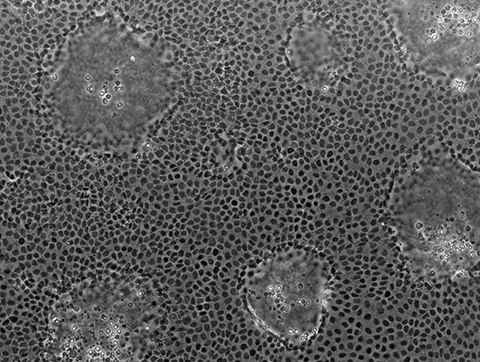Gut microbes could be key for cancer therapies
Microorganisms produce substances that play a role in several of the human body’s metabolic processes. In some cases, the specific function and mechanism of action of these metabolites still mystify scientists. Uncovering these mysteries could lead to groundbreaking targeted therapies for cancer and other diseases.
The short-chain fatty acid butyrate is a bacterial metabolite involved in intestinal homeostasis that serves as a source of energy and initiates differentiation in epithelial cells. Because low cell differentiation is a characteristic of cancer cells, cancer researchers try to understand how bacterial metabolites such as butyrate affect epithelial cell differentiation and molecular phenotype.

Katarina Madunić and a team of scientists in the Netherlands investigated the effect of bacterial butyrate on glycosylation and differentiation in an epithelial cell line derived from a human colorectal carcinoma in 1977 and known as Caco-2. They recently published their findings in the journal Molecular & Cellular Proteomics.
Mass spectrometry, or MS, separates molecules based on their mass-to-charge ratio and is frequently used to study metabolites. However, Madunić’s team was analyzing glycans that had identical masses, so the usefulness of MS was limited. To overcome this limitation, they used a unique separation technique called porous graphitized carbon nano-liquid chromatography with electrospray ionization tandem MS.
Manfred Wuhrer, the corresponding author of the study, explained that this method uses a “high-end charcoal variant that separates the sugars one by one, hence resolving the isomers for mass spectrometric characterization.”
This unique approach was pioneered by a group of Australian researchers who published about it in 2004. It proved to be a technique that Madunić’s team could build upon for their investigations.
The researchers were surprised to find that the glycosylation of differentiated cells from the CaCo-2 cell line was substantially different from the glycosylation of other differentiated colorectal cell lines from their previous work.
Madunić said this finding “made us look into the changes in the cell proteome, from which we formed interesting hypotheses about the importance of glycan building block availability in the cell culture media influencing the cell glycosylation changes.”
In this study, the researchers wanted to investigate changes in glycosylation that occurred during differentiation in a particular cancer cell line. They did so, identifying specific O-glycans along with specific protein expressions that mark butyrate-induced versus spontaneous epithelial cell differentiation.
These findings are a step toward creating a repository of cancer-implicated metabolic and associated glycomic signatures. Such a repository can be used to further study the pathophysiology of various cancers and, consequently, to help develop targeted cancer therapies.
In future studies, the researchers hope to use more robust multiomics analysis to provide more depth to their findings and provide more mechanistic insights, Wuhrer said.
“We would like more information on the cellular metabolic signature and the expression of the glyco-genes, which shape the O-glycans. How is this evolving and changing upon bacterial metabolite exposure?”
Enjoy reading ASBMB Today?
Become a member to receive the print edition four times a year and the digital edition monthly.
Learn moreGet the latest from ASBMB Today
Enter your email address, and we’ll send you a weekly email with recent articles, interviews and more.
Latest in Science
Science highlights or most popular articles

Mining microbes for rare earth solutions
Joseph Cotruvo, Jr., will receive the ASBMB Mildred Cohn Young Investigator Award at the ASBMB Annual Meeting, March 7–10, just outside of Washington, D.C.

Fueling healthier aging, connecting metabolism stress and time
Biochemist Melanie McReynolds investigates how metabolism and stress shape the aging process. Her research on NAD+, a molecule central to cellular energy, reveals how maintaining its balance could promote healthier, longer lives.

Mapping proteins, one side chain at a time
Roland Dunbrack Jr. will receive the ASBMB DeLano Award for Computational Biosciences at the ASBMB Annual Meeting, March 7–10, just outside of Washington, D.C.

Exploring the link between lipids and longevity
Meng Wang will present her work on metabolism and aging at the ASBMB Annual Meeting, March 7-10, just outside of Washington, D.C.

Defining a ‘crucial gatekeeper’ of lipid metabolism
George Carman receives the Herbert Tabor Research Award at the ASBMB Annual Meeting, March 7–10, just outside of Washington, D.C.

The science of staying strong
Muscles power every movement, but they also tell the story of aging itself. Scientists are uncovering how strength fades, why some species resist it and what lifestyle and molecular clues could help preserve muscle health for life.

